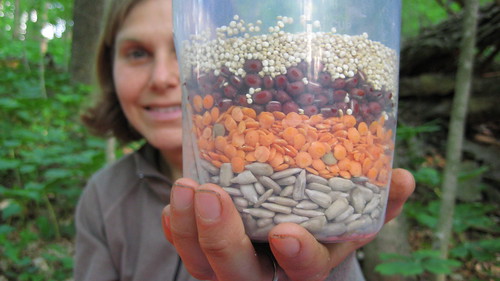Typical Day In Our Thru-Hiker Kitchen

So what are we eating on the trail to power our attitudes and legs for 20 miles a day?
Back home we've done a lot of experimenting with living foods and have found that they work well for my diabetes and that we're both energetic and in peak shape. We've been eating "raw" for nearly 2 years now - raw fruits, vegetables, seeds, nuts, grains and greens.
Well, after 3 weeks on the trail, our appetites have definitely ramped up and our bodies now know these miles are a daily ritual, not just a fluke. We've gotten to the point when we sit down to eat, we don't want to stop. So sometimes we aren't so picky about what form the calories come. But Ben and I have noticed a big difference in our hunger, cravings and appetites on our diet compared to what a more typical thru-hiker is experiencing.
It's been our plan to include as many living foods as possible on our thru-hike. We believe that food which comes straight from the earth, eaten in its simplest form, gives the most nutrition, energy and life force to our bodies. So, what exactly fills our food bags?
Breakfast: Dried fruits and nuts, or meal bar that combines them - such as Larabar.
Lunch and Snacks: Energy-packed concentrated meal bars with whole grains, fruit, honey, nuts - Such as Bear Valley's Pemmican or MealPack Bars - and then more figs!
Dinner: Sprouts, soaked overnight, mixed with instant dried hummus or other powdered carbohydrate. And don't forget the Texas Pete.
Dessert: (Most Important!) Dark chocolate & countless spoonfulls of almond butter or PB.
At dinner we've been eating a combination of 4 different types of sprouts. I specifically chose ones that are complete proteins when eaten together, that sprout quickly (less than 2 days), and can be found easily in towns without health food stores.
We really feel satisfied so far and do not experience AYCE (all-you-can-eat) cravings for meat, bread, and just TONS of food, like many other hikers on a more standard backpacking diet. It's been amazing, really. We know one hiker who was coming into town today to eat some burritos and an entire pizza!
So while we're at home we prefer fresh, uncooked foods - and while we're on the trail we're doing the best that we can.
Hi there! Just stumbled upon your journal today, trying to find some info on the AT. A friend and I are planning on hiking in the spring. Anyways, I am impressed to hear that you both hiked on a raw diet. I don't eat a fully raw diet but that is my goal, and I don't want the AT to be an exception. I'd love to get some advice from you as far as what kinds of foods you ate specifically. Please contact me at stevebaklik@gmail.com. Thank you, and thank you so much for the inspiration!
ReplyDeleteHi Steve,
ReplyDeleteNice to hear from you!
Yes, we were 100% raw leading up to the trail, and ate probably a 60% raw diet on the trail. The main 'processed' foods that we incorporated were instant potatoes & hummus, pemmican bars, clif bars and peanut butter.
Raw foods that we relied on were Trader Joe's almond butter, almonds & walnuts, raisins, sprouted legumes, Lara Bars. It's pretty easy to carry fresh produce for the first couple days
There was also this 'pea-tendril' looking plant called a greenbriar in North Carolina through New Jersey(?) that we were gathering and adding to our dinners. Also dandelion greens.
Another treat in some sections were blueberries and blackberries, but they we're sporadic.
Overall, I feel that being active and getting nutrients is far more important than being 'religiously' raw. We felt incredibly nourished on the trail and were not ravenous like most other hikers when we hit town. But I also enjoyed my fair share of oatmeal cream pies out there too.
It's pretty easy to fall into a tunnel vision mentality with all of the raw food hype. We've adopted a bit more relaxed view about raw food since being home from the trail. Yes, it is still by far what we choose to prepare for ourselves on a daily basis. We still prefer a mostly vegan primarily vegetarian diet. It makes sense on so many levels. But we've also come to realize that we are willing to be flexible with our diet so that we are able to connect on certain social settings, and so that we do not miss unique cultural experiences.
Ultimately, you've got to figure out what works best for you. As far as the trail goes, don't let this one pass you by. And with the stalled economy, I can't think of a better time to get out there and hike!
Let me know if you have any further questions.
_Ben